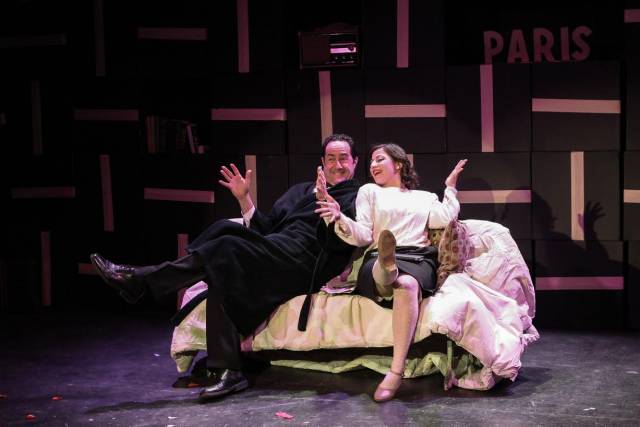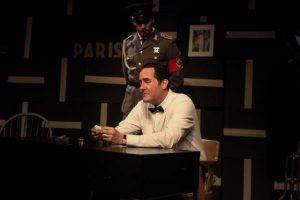

The term that most aptly defines Defendant Maurice Chevalier, Alexis Chevalier’s play about his great-granduncle, is structure; structure with regards to both the play itself and with regards to what this play represents. Regarding the play, it is the structure of a thought-provoking narrative that is centered on the interrogation in 1945 of the French superstar Maurice Chevalier enquiring into his entanglements with the Nazis, the Collaborators, and the Resistance in WWII. It is also the living spatial structure of the staging and choreography, which is as sharp and precise throughout the play as a clockwork toy. With regards to what the play represents, it is the structure of nations and ideologies which during the period in question were being violently warped and manipulated.
Apart from being stretched somewhat too thin, the narrative of Defendant Maurice Chevalier, told through confessionary recollections, is an intriguing dive into the memories the famous singer during a time when his loyalties -- and indeed the loyalties of everyone -- were held up to intense scrutiny. The play shows how Chevalier’s image was skewed by schemes he instigated or supported in order, according to this play, to protect the people who were dear to him, to protect his artistic integrity, and, quite simply, to compromise with the powers that were when they forced him into situations of increasing moral ambiguity when he had little real say in the matter. The narrative structure allows for subjective ruminations and musical dance sequences, which assume an odd role outside the main narrative thread, as if the songs and dance colored the memories rather than took place within them.

The choreography is fairly simple yet fairly topnotch, as well. The musical sequences are carefully paced, with one in particular that takes on an almost David Lynch-like weirdness. The basic staging of the play carries the actors, who are all quite fine in their own rights, through the drama seamlessly. When it transitions into the musical interludes, a tricky thing occurs, in that the song and dance is not for the most part chronologically fitted into the dramatic structure. The musical sequences are digressive, rather than progressive -- they deviate from the story rather than push it forward -- and yet this is one of the play’s greatest strengths, for it serves to comment on the position of Chevalier during the war.
The musical sequences in Defendant Maurice Chevalier frequently occur at the points of highest tension and as such they serve as a kind of lifeboat, freed from and floating on the overall structure. They contain a protective quality, delaying the fruition of threat or danger or the intrusion of the bad. The songs and dance in essence transcend the narrative structure of the play in much the same way that Chevalier’s art transcended the structure of the global stage during the war years. Throughout his career, Chevalier was seen as a symbol of France, but his appeal ultimately was a universal joie de vivre detached from nationalistic ideologies in any real political sense. It was this very universality that allowed Chevalier to be used by various factions; to be appropriated freely as a political symbol. Because his art appealed to basic human emotions sans politicization, his art could be easily attached to any political faction and politicized even contrary to the intentions of Chevalier himself. This play in the end slices the structures apart and seeks to free the man and the artist trapped within them with both plenty of entertainment and plenty of food for thought.